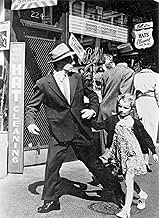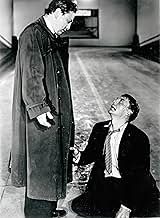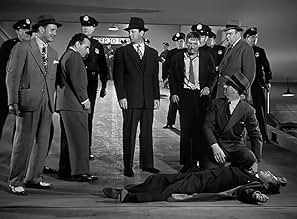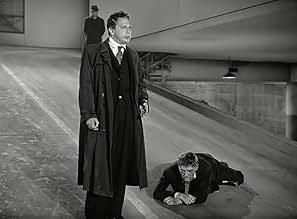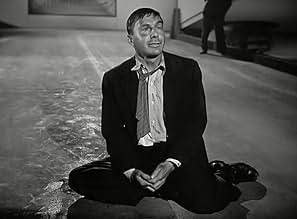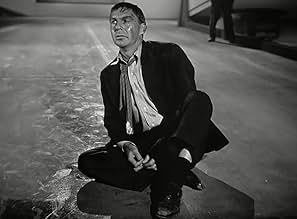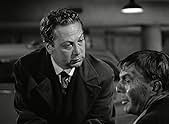Dans cette américanisation du thriller allemand de 1931, la police et la pègre traquent un tueur mystérieux qui s'en prend aux jeunes enfants.Dans cette américanisation du thriller allemand de 1931, la police et la pègre traquent un tueur mystérieux qui s'en prend aux jeunes enfants.Dans cette américanisation du thriller allemand de 1931, la police et la pègre traquent un tueur mystérieux qui s'en prend aux jeunes enfants.
- Réalisation
- Scénario
- Casting principal
- Lemke
- (as Lennie Bremen)
Avis à la une
Martin W. Harrow (David Wayne) is a reclusive serial killer who has already gained notoriety throughout the city after a few dead bodies were found, minus their shoes. Inspector Carney (Howard Da Silva) feels the pressure of expectation, resorting to desperate measures by fleecing the regulars at a known criminal hangout in the hope of stumbling upon a clue or lead, as the city's residents are in high- paranoia mode, reporting anyone acting remotely suspicious or seen walking with a child. One old man is hauled in after helping a young girl take her skates off after a fall. Syndicate boss Charlie Marshall (Martin Gabel), seeking an opportunity to divert the attention away from his own criminal activities, rounds up his gang of crooks and brings in drunken lawyer Dan Langley (Luther Adler) in the hope of tracking down the murderer himself.
Any American remakes of foreign masterpieces will always be looked upon with some degree of disdain, and I must admit that I went into M expecting a pointless re-hash of what came before. However, under the disguise of a film noir, Losey's M is a damn good movie, with the panic-stricken city eager to turn over their neighbour in the hope of sleeping easy at night easily comparable with Joseph McCarthy's Communist witch-hunts terrorising Hollywood at the time, which saw industry giants pressured into naming names and exiling their co-workers onto the Blacklist. As Harrow, Wayne is subtly effective, sweet-talking his victims and luring them with his whistle. More focus is given to his character than in Lang's film, and Wayne manages to invite more sympathy than Peter Lorre's incarnation as he is eventually hauled in front of a public jury. It certainly doesn't have the dramatic weight or technical wizardry of the 1931 version, but Losey's effort stands out as one of the most gripping noirs of its era.
There's a serial killer of little girls operating in a small American city and it's got the police baffled. With conditions as they are the police turning up the heat, organized crime types can't operate so the local Don played by Martin Gabel starts his own manhunt. He can move into places local police chief Howard DaSilva can't.
The killer is mild mannered David Wayne a truly pitiable sort when unmasked. His devolution of defenses is something to see.
Good ensemble cast worked with the leads. A good remake of a classic.
Thanks to Losey 's talent ,the Americanization of "M" was a success. Please do not redo now!
Like anyone else, I assumed this would be an inferior version of the Lang classic, but this movie stands alone and takes the already disturbing plot to a very '50's place.
If you're interested in noir, and you're seen the original M, you definitely, so much, HAVE to see this. The performance from David Wayne rivals Peter Lorre's and if nothing else, for you Americans, he is surprisingly sympathetic and relate-able.
The original M is one of the first great thrillers and bridges the gap between expressionism and what would become noir in film. This movie serves an exact opposite purpose - it takes the plot of "M" and does an amazing job of turning it in to a local film that both serves as a great thriller and a great commentary on our society.
Was it the growing Blacklist that resulted in this movie having no writing credits on screen? Perhaps, but also perhaps not, as the soon-to-be-blacklisted Howard da Silva and Joseph Losey both use their own names.
Losey and his team make excellent use of numerous Los Angeles locations, including Angel's Flight, Bunker Hill, the Bradbury Building (which is identified by name and location) and what seems to be that old amusement park in Long Beach, although what's seen here could be Venice.
David Wayne is fine as the disturbed child killer, and delivers the required final act speech very well. But he doesn't have the power and poetry of Lorre's performance--but then who in Hollywood in 1951 would have? The movie still has some of the comedy of Lang's original, but it's not as dry and sardonic, and there isn't as much of it. The score isn't good, and shoves the movie even more firmly in the direction of the melodrama it keeps threatening to become.
The very last shot is oddly theatrical in a literal sense: it looks like it is being performed on a stage. And I'm not sure what the point of the drunken lawyer trying to grasp a bit of his former glory really was. However, this element merely weakens the film, it doesn't destroy it.
No, this isn't as good as Lang's original, but Lang's original is perhaps the best film of a great director. It's a classic in almost every regard. This version of "M" is an interesting and largely successful attempt at adapting the themes and ideas of the original to Los Angeles, and to 1950s Hollywood. Naturally there are some weaknesses, but the movie is brisk and engrossing, and certainly doesn't deserve the obscurity into which it has fallen.
Some condemn the film merely for being a remake, but remakes have always been a large part of movie history. There's little reason to object to them, especially now that the original films tend to be available on video. (In the 1930s-50s, originals were generally withdrawn.) If the remake is good, then hooray, there are now two good movies on the subject. If it's bad, then the remake will soon be forgotten.
Le saviez-vous
- AnecdotesBefore signing Joseph Losey as director, producer Seymour Nebenzal approached fellow German expatriate Douglas Sirk and offered him the job. Sirk said he would do the film only if he could scrap the original story and write a new one about a psychopathic murderer of children. When Nebenzal approached Losey, he also wanted to scrap the original story and do a new one about a child murderer, and Nebenzal told him that the Production Code Administration (PCA) had agreed to allow him to make the film only if the original story and script were kept. The PCA had approved "M" as a remake of an acknowledged classic, but if the story were changed, its approval would be withdrawn.
- GaffesWhen the killer and the little girl are locked in the room, the large shadow of the microphone boom is clearly visible on the wall on the left side of the screen after she sits down on the floor.
- Citations
Police Chief Regan: To prevent other crimes, your police department has prepared five don'ts. DON'T let your children accept rides from strangers, sometimes these are one-way rides leading to death. The amiable stranger may be a killer. DON'T let your children accept presents from strangers. A bag of popcorn or a candy bar is not worth your child's life. DON'T send children on after-dark errands, the night works in behalf of the killer who preys on our young. If you must have something from the store after sundown, get it yourself. DON'T let your child play unattended in wooded places or empty lots. Though your eyes aren't on them, somebody else's may be watching. DON'T let your children become friendly with Pop, that nice old character in your neighborhood. Most of these men are harmless, but there are exceptions. It's up to you to make sure your child isn't the victim of one of these exceptions. And now for one all important do: If you notice any suspicious characters lurking around schools and playgrounds, DO call at once, your police department: Central 5000, the life you save may be your child's life.
- ConnexionsFeatured in The 3 Faces of M (2022)
Meilleurs choix
Détails
- Date de sortie
- Pays d’origine
- Langue
- Aussi connu sous le nom de
- M
- Lieux de tournage
- Bradbury Building - 304 S. Broadway, Downtown, Los Angeles, Californie, États-Unis(building where Harrow is trapped)
- Société de production
- Voir plus de crédits d'entreprise sur IMDbPro
- Durée1 heure 28 minutes
- Couleur
- Rapport de forme
- 1.37 : 1
Contribuer à cette page


